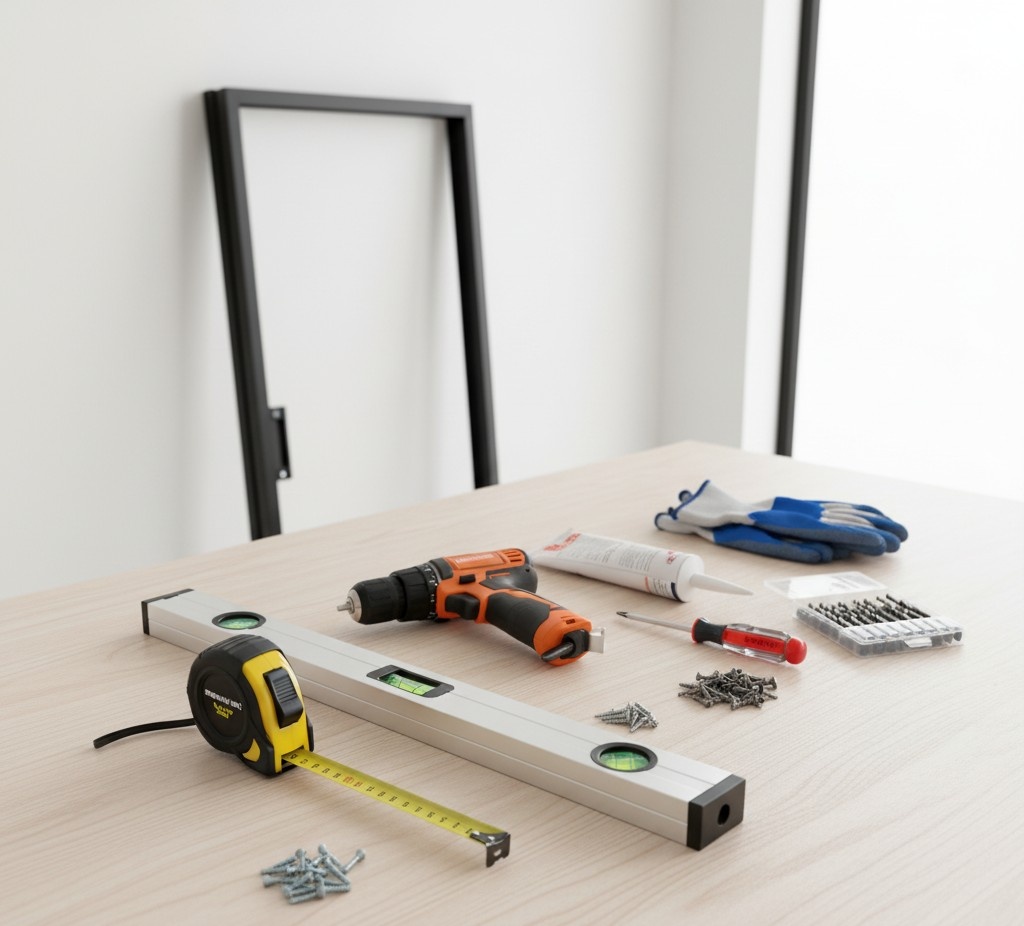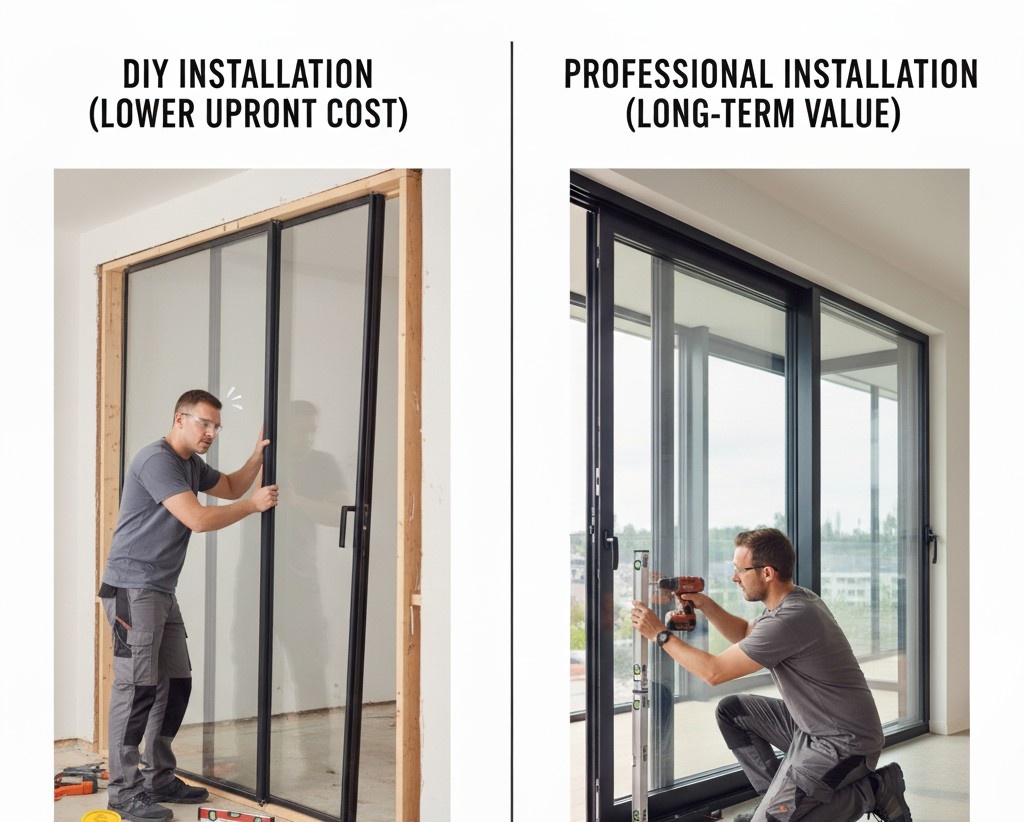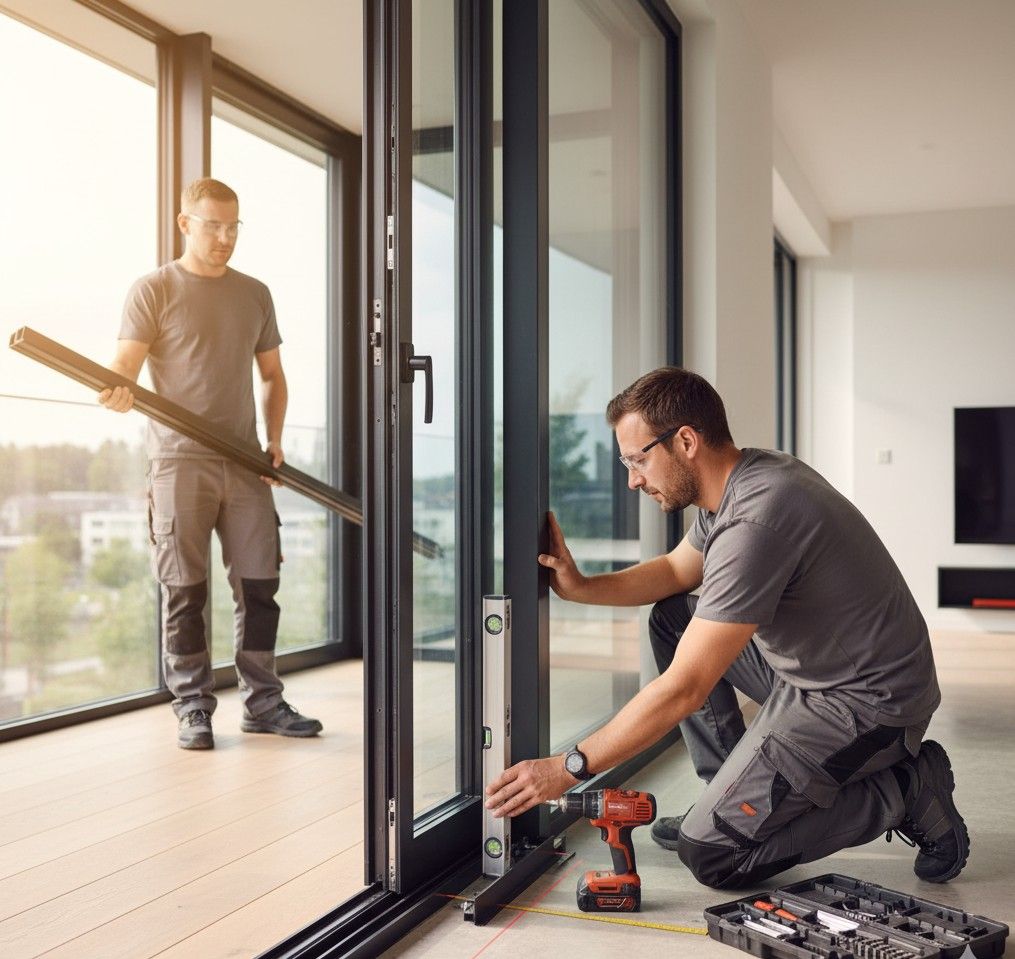Swing sliding doors are a modern door solution that combine sleek aesthetics with practical functionality. Unlike traditional door systems, which either swing or slide, swing sliding doors offer the unique advantage of performing both actions. This makes them highly versatile for both residential and commercial properties, where space optimization and design appeal are equally important.
They are increasingly popular in contemporary construction projects, not only for their space-saving features, but also for their ability to improve indoor–outdoor flow, enhance natural lighting, and provide durability for high-traffic areas.
Key Takeaways:
- Swing sliding doors combine swinging hinges with sliding tracks for space-saving, durable, and versatile openings.
- Installation requires accurate measurement, frame preparation, track alignment, hinge fixing, and lock adjustments.
- Common issues include misaligned tracks, noisy hinges, lock problems, gaps, water leaks, and heavy panels.
- Costs vary by material and installation method, with aluminum frames and insulated glass offering long-term savings.
What Are Swing Sliding Doors?
Swing sliding doors, also known as “PT doors” or “Pro-Fix doors,” combine the features of both swing and sliding doors, allowing the panels to be pushed or pulled open flat and then folded or slid away for maximum space efficiency and flexibility.
Unlike traditional bi-folding doors that concertina open or standard sliding doors, a swing sliding door opens by swinging inward or outward before sliding to a desired position, providing more ventilation and access options.
When closed, they form a secure, solid wall, and they don’t intrude into living or external spaces, making them ideal for maximizing home layouts.
Mounted on both rollers and hinges, these doors can:
- Slide horizontally along tracks, saving space.
- Swing open inward or outward, offering easy passage.
In short: swing sliding doors provide the best of both worlds the openness of a swing door combined with the space-saving efficiency of aluminum sliding doors.
Benefits of Swing Sliding Doors
- Space-Saving: Eliminates the clearance needed by traditional hinged doors.
- Aesthetics: Sleek, modern, and ideal for contemporary architecture. According to Architectural Digest, glass-integrated sliding systems are increasingly favored in modern builds for their seamless indoor–outdoor transitions.
- Durability: Frames made from aluminum doors ensure strength and long-term use.
- Accessibility: Easy to operate, ideal for both homes and businesses.
- Insulation: Provides effective noise and weather resistance when sealed properly. Energy.gov notes that insulated glass and weatherstripping significantly reduce heating and cooling costs in residential and commercial spaces.
Comparison: Swing Sliding Doors vs Traditional Door Systems
|
Feature |
Swing Sliding Doors | Traditional Sliding Doors |
Hinged Swing Doors |
| Space Efficiency | High – panels slide & swing | High – panels only slide | Low – needs swing clearance |
| Aesthetic Appeal | Modern, seamless design | Contemporary | Classic |
| Accessibility | Easy swing + slide mechanism | Sliding only | Swing only |
| Durability | Strong aluminum + hinge support | Moderate (track-reliant) | Strong hinge-reliant |
| Best Use Case | Homes & commercial projects | Balconies, patios | Interior rooms |

Pre-Installation Preparation
Tools & Materials Needed
- Measuring tape
- Drill & drill bits
- Level
- Screwdriver set
- Screws & anchors
- Hammer
- Sealant/foam insulation
- Safety gear (gloves, goggles)
Comparison: DIY Tools vs Professional Tools
|
Tools Needed |
DIY Installation |
Professional Installation |
| Measuring tape | ✅ Basic | ✅ Industrial-grade |
| Drill | ✅ Standard home drill | ✅ Heavy-duty professional set |
| Level | ✅ Carpenter’s level | ✅ Laser precision level |
| Sealant/foam | ✅ Standard sealant | ✅ Industrial waterproof seal |
| Safety gear | ✅ Gloves, goggles | ✅ Full protective equipment |
Measuring the Space
- Width & Height: Take measurements at three points (top, middle, bottom). Record the smallest values for accuracy.
- Check Alignment: Use a level to confirm walls and floors are straight.
- Wall Condition: Ensure the structure is sound enough to support the door system.
Choosing the Right Door
When selecting swing sliding doors, consider:
- Frame Material: Aluminum doors are lightweight, strong, and corrosion-resistant.
- Glass Type: Clear, tinted, laminated, or insulated for energy efficiency.
- Custom Options: Handles, locks, and finishes that match project needs.
- Other Openings: For areas like kitchens or bars, fold-up windows can be paired with doors to maximize airflow.
- Certifications: Compliance with international building codes.
Step-by-Step Installation Process
Step 1: Frame Preparation
- Remove existing door/frame.
- Smooth and clean the surface.
- Check alignment with a level.
Step 2: Installing the Track System
- Position upper and lower tracks in place.
- Drill holes and secure with screws.
- Ensure tracks are perfectly level to avoid sliding issues.
Step 3: Mounting the Door Panels
- Attach rollers to the panels.
- Insert panels carefully into the track.
- Test the sliding motion before securing fully.
Step 4: Fixing the Swing Hinges
- Attach hinges to designated points.
- Adjust tension for smooth swinging motion.
- Balance swing and sliding functions.
Step 5: Adding Handles & Locks
- Install chosen handles (lever, pull, recessed).
- Fit locks and test alignment.
- Use custom handles/locks where aesthetics matter.
Step 6: Testing & Adjustments
- Slide and swing doors several times.
- Adjust rollers, hinges, or strike plate as needed.
- Ensure locks engage securely.
Comparison: DIY vs Professional Installation
| Factor | DIY Installation |
Professional Installation |
| Skill Level | Moderate – requires tool knowledge | Expert precision |
| Time Required | 6–10 hours | 4–6 hours |
| Cost | Lower upfront, risk of mistakes | Higher upfront, fewer errors |
| Warranty Coverage | Not included | Often included |
Post-Installation Tips
- Seal Gaps: Apply weatherstripping or foam insulation.
- Lubrication: Keep rollers and hinges oiled.
- Track Cleaning: Remove dust and debris regularly.
- Safety Checks: Ensure locks and handles remain secure.
For windows that complement swing sliding doors, gas strut windows can be used to create easy pass-through openings.
Troubleshooting Common Issues
1. Door Not Sliding Smoothly
- Cause: Misaligned tracks, dirt buildup, or worn rollers.
- Solution: Clean tracks, realign, or replace rollers.
| Symptom | Cause |
Fix |
| Stuck mid-track | Debris in track | Clean thoroughly |
| Uneven sliding motion | Track misaligned | Adjust/reinstall |
| Grinding sound | Worn rollers | Replace rollers |
2. Hinges Making Noise
- Cause: Dry or loose hinges.
- Solution: Lubricate with silicone oil, tighten screws, replace if needed.
3. Locks Not Aligning Properly
- Cause: Frame shift or poor hinge alignment.
- Solution: Adjust strike plate, reposition lock, or realign hinges.
4. Gaps Around the Door
| Gap Type | Likely Cause | Fix |
| Small gaps | Worn weatherstripping | Replace with foam or sealant |
| Large gaps | Misaligned frame | Re-align or reinstall door frame |
5. Glass Panels Rattling
- Tighten clips, reapply sealant, or replace seals.
6. Water Leakage During Rain
- Clear clogged drainage channels, apply waterproof sealant, add drip caps. Home Depot provides tutorials on weatherproofing and sealing to prevent leaks.
7. Heavy Panels Hard to Move
- Upgrade to heavy-duty rollers or add additional roller support.

Cost & Value Considerations
1. Installation Costs: DIY vs Professional
- DIY: Cheaper but risk of errors.
- Professional: Higher upfront, better precision.
Average Range:
- Residential doors: $300–$600 (DIY), $700–$1,200 (pro).
- Commercial/custom: $1,500–$3,000+.
2. Material & Design Impact
- Aluminum: Durable, mid–high cost.
- Glass: Laminated or insulated increases cost but improves efficiency.
- Custom Hardware: Adds cost but boosts design appeal.
3. Long-Term Value
- Energy Savings: Lower utility bills.
- Durability: Fewer replacements.
- Property Value: Enhances resale appeal.
Comparison: Short-Term Cost vs Long-Term Value
| Aspect | Short-Term Focus | Long-Term Value |
| Initial Expense | Lower with basic/DIY | Higher with custom insulated models |
| Energy Bills | Remain high | Lower with energy-efficient glass |
| Maintenance | More frequent | Minimal with aluminum & tempered glass |
| Property Value | Neutral | Higher resale appeal |
Why Choose Oridow for Swing Sliding Doors
- Manufacturer Expertise: China-based aluminum door and window specialist.
- Customization: Tailored solutions for builders, wholesalers, and architects.
- Certifications: Meets international safety and performance standards.
- Export Experience: Trusted worldwide by developers and distributors.
- Support & Warranty: Backed by after-sales service.
Looking to upgrade your next project with swing sliding doors?
- Request a Free Quote to explore pricing.
- Contact Oridow for customized solutions.
Visit Oridow’s Official Website today.
FAQs About Swing Sliding Door Installation
1. How long does installation take?
Typically 4–6 hours for professionals, longer for DIY.
- Simple units: 3–4 hours
- Large/custom projects: 6–8 hours
2. Can they be used in small spaces?
Yes. Their sliding function saves space where swing clearance is limited.
- Ideal for apartments and offices
- Better than hinged-only doors in compact rooms
3. What materials work best?
- Aluminum: Lightweight, durable, corrosion-resistant.
- Glass: Clear, tinted, laminated, or insulated for performance.
4. Do they provide insulation?
Yes, especially with insulated glass and weatherstripping.
- Reduces noise
- Improves thermal efficiency
5. What maintenance is required?
Minimal but important for long life.
- Clean tracks monthly
- Lubricate rollers/hinges every 6 months
- Inspect locks and seals regularly
6. Are they secure?
Yes. They feature reinforced aluminum frames and multipoint locks.
- Locking systems prevent forced entry
- Laminated glass boosts safety
7. How much do they cost?
Depends on size, material, and customization.
- Small residential: Moderate
- Large/commercial: Higher investment
- Long-term savings with energy-efficient models





